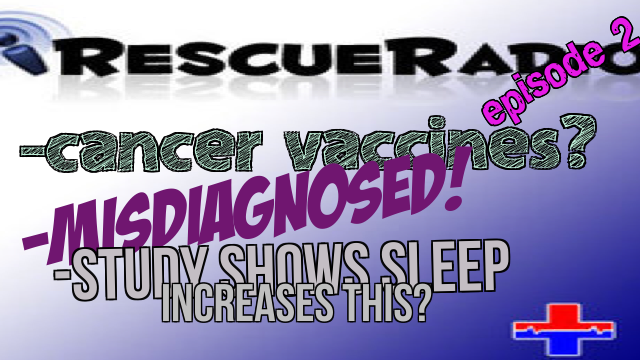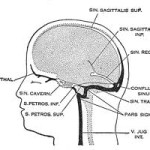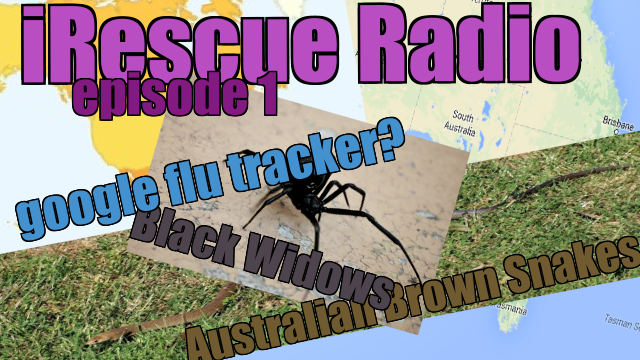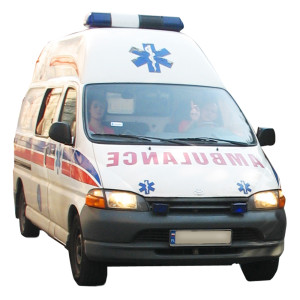It can be very scary to have a medical emergency but even more scary if you’re all alone with no one to help. In this video, I explain what to do if you have chest pain or you think you’re having a heart attack and your alone.
If you’ve ever wondered what to do when you’re experiencing a medical or life threatening emergency and you find yourself alone, you may get the answer you’re looking for right here, on this episode of RoyOnRescue!
Tag Archives: medical
iRescueRadio 002: Stem Cells, Overworked Doctors, Cancer Vaccine, Asthma, and Sleep
 This episode of iRescueRadio was originally released in November of 2008. In it we discussed how stem cells have shown to help the body accept an organ transplant; we investigated the reasons for misdiagnosis of asthma and other illnesses, such as overworked doctors and excess paperwork; a new skin cancer vaccine is discussed; and the power of sleep as a memory aid and an important agent to fight cancer.
This episode of iRescueRadio was originally released in November of 2008. In it we discussed how stem cells have shown to help the body accept an organ transplant; we investigated the reasons for misdiagnosis of asthma and other illnesses, such as overworked doctors and excess paperwork; a new skin cancer vaccine is discussed; and the power of sleep as a memory aid and an important agent to fight cancer.
Can Deadly Spiders Live In Store Boxes? Can Computers Track The Flu? Find Out Now!
This episode was originally recorded in 2008. It was our first broadcast of 45 total before we ended the show.
On this week’s iRescueRadio, we cover stories ranging from a Canberra, Australian man who gets bit by an extremely deadly Australian Brown Snake… and lives! Next, a boy in Belding, Michigan is bit by a black widow spider…guess where it came from! And then, we cover Google Flu Trends and a hilarious look at the effects of music on your health. All this on this episode of iRescueRadio. Listen now by clicking on the play arrow below.
Meteorite Explodes Over Russia Injuring Thousands!

I tried to release this video episode on Friday and unfortunately had some media problems. I wanted to make sure to address some of the questions regarding how people could be injured by the Meteor explosion if it never hit the earth. Great question, because the meteorite entered earths atmosphere so fast and burned so brightly when it came in, it drew thousands of peoples attention and they went near windows to gaze up at the aftermath of it’s entry. While people were standing by, the sonic boom was so loud, it shattered windows, caved in buildings and in some cases even blew in doors. The shards of broken glass was the greatest cause of injuries. But some reports said there could have been ear drum damage, some eye and vision disorders and I believe even one cardiac arrest though this may be hard to confirm. If you have any interest in what happened want to see shocking footage and how these injured people could have protected themselves, be sure to watch this episode of RoyOnRescue.
What Is Cerebral Venous Sinus Thrombosis?
Hello Rescuers!
I received an email from a RoyOnRescue friend who had suffered a head injury while playing a sport. After being seen by the doctor he was diagnosed with Cerebral Venous Sinus Thrombosis or (CVST). He had asked me if I would give my explanation of what it is and if it was something he should be worried about. His doctor had ex plained it but he was still a bit foggy regarding the diagnosis. Well, after looking into it from the clinical perspective, I realized that it was a pretty big deal and in some cases may be fatal. I researched multiple sources to gather credible information and when it all came down to brass tacks, I found that the Wikipedia explanation had done a pretty dog-gone good job of summarizing CSVT. So, with all credit given to them for most of this article and a link back to their website, here it is.
plained it but he was still a bit foggy regarding the diagnosis. Well, after looking into it from the clinical perspective, I realized that it was a pretty big deal and in some cases may be fatal. I researched multiple sources to gather credible information and when it all came down to brass tacks, I found that the Wikipedia explanation had done a pretty dog-gone good job of summarizing CSVT. So, with all credit given to them for most of this article and a link back to their website, here it is.
I have personally responded and treated many different types of head injuries as a paramedic but had not researched this problem to this level. Then, shortly after receiving this question, I read that Secretary of State, Hillary Clinton was diagnosed and hospitalized with the very same problem secondary to her head injury! Ironic. So, I thought to myself, if two people experienced this problem secondary to a common traumatic head injury(concussion), there may be more with the same question.
Here’s my trimmed-down version of what it is, what it’s symptoms are, how to determine if it is truly CSVT and then what a person may want to do if they think they may be suffering from such a complication. So let’s dig into some of the questions you may have! P.S. You’ll notice there are more links then usual in this article. The topic is so complex and has so many different facets I thought it wise to allow you to do some of your own information mining and hope the links make it easier.
Q: What is a cerebral venous sinus thrombosis anyway?
A: A CVST is the presence of thrombosis (a blood clot) in the dural venous sinuses, which drain blood from the brain.
Q: What causes a CVST?
A: There can be many causes of CVST. Here is a few I included:
- Thrombophilia, a tendency to develop blood clots due to abnormalities in coagulation, e.g. factor V Leiden, deficiency of protein C, protein S or antithrombin, or related problems
- Nephrotic syndrome, a kidney problem causing protein loss in the urine
- Chronic inflammatory diseases, such as inflammatory bowel disease, lupus and Behçet’s disease
- Pregnancy and puerperium (the period after giving birth)
- Particular blood disorders, especially polycythemia vera and paroxysmal nocturnal hemoglobinuria
- Use of estrogen-containing forms of hormonal contraception
- Meningitis and infections of the ear, nose and throat area such as mastoiditis and sinusitis
- Direct injury to the venous sinuses
- Medical procedures in the head and neck area
- Sickle cell anemia
- Dehydration, primarily in infants and children
- Homocystinuria
Q: How might I know if I have a CVST?
A: Headache that may worsen over the period of several days, but may also develop suddenly. Strangely the headache may be the only symptom of cerebral venous sinus thrombosis. Stroke, 40% of all patients have seizures, Common symptoms in the elderly with this condition are otherwise unexplained changes in mental status and a depressed level of consciousness. The pressure around the brain may rise, causing papilledema (swelling of the optic disc) which may be experienced as visual problems. In severely raised intracranial pressure, the level of consciousness is decreased, the blood pressure rises, the heart rate falls. This is a common symptom found in closed head injuries which makes sense as the mechanism is very similar.
Q: How will the doctor know if this is what I have?
A: The most commonly used tests are computed tomography (CT) and magnetic resonance imaging (MRI), both using various types of radiocontrast to perform a venogram and visualise the veins around the brain
Q: How is a CVST treated and cured?
A: Treatment is with anticoagulants (medication that suppresses blood clotting), and rarely thrombolysis (enzymatic destruction of the blood clot). Given that there is usually an underlying cause for the disease, tests may be performed to look for these. The disease may be complicated by raised intracranial pressure, which may warrant surgical intervention such as the placement of a shunt.
A: Yes. Like any illness or injury that causes a problem with the circulation of oxygenated blood to our tissues, this type of problem can be very dangerous if left untreated. It also runs a risk of complication in that it raises the intracranial pressures which can act similar to a closed head injury and this too can cause severe injury or death. If a person has any of the symptoms listed above, they should be seen as soon as possible to rule out this potentially life threatening disorder. If a person is reacting with decreased level of consciousness, or any type of life threatening complications, activation of Emergency Medical Services or 911 should be immediate with life saving or time buying intervention given.
I hope this helps and keep well!
See Source:
http://en.wikipedia.org/wiki/Cerebral_venous_sinus_thrombosis
http://neurology.jwatch.org/cgi/content/full/2007/515/2
http://www.medscape.com/viewarticle/705510_3
iRescueRadio 042: Fainting, Aliens, Sleep Paralysis, Dreams
Sleep disorders affect millions of people. Associated problems can range from feeling tired during the day to life threatening cardiovascular damage. If you have had difficulty with sleep maybe it is something other than a medical condition. Maybe it is those pesky aliens that keep abducting people in the night. Are aliens abducting people or could it be sleep paralysis? You’ll have to listen in to find out. The iRescueradio guys are up to their usual antics with Dan’s fainting, Roy’s research, and Jody’s dreaming.
We’ve included a bonus feature this week, a “behind the scenes” blooper. Jody learned a valuable lesson about reviewing research before trying to use it.
Links:
iRescueRadio 041:Spiders, Insect Bites, Rescue Dog, Good Sounds
Its been a good week at the iRescueradio studio. A little training, something interesting and lots of fun are all wrapped up in this show. You’ll have to listen to find out why Dan’s going buggy, Jody’s in a different camp, and Roy’s letting out some interesting sounds.
iRescueRadio 040: Welcome back, Airsickness, Toilet Phobia
iRescueradio has been retooled and is on again after some time away. Thank you to our number one fan, Ryan, for encouraging us in our endeavors. You won’t want to miss this comeback show where Dan shares an upsetting story, Roy flushes out an interesting article, and Jody laughs alot.
iRescueRadio 017: A Special Guest Host to Intern in China, what Health Issues could he face?
This episode of iRescueRadio features our regular hosts, Roy, Dan and Jody. And it also has a special guest: Tyler. It’s a fun episode that is a bit of a departure from our regular format.
They talk about Tyler’s upcoming internship in China this summer and the health issues that may result from that if Tyler is not careful.
Enjoy it! It’s a really fun listen.
iRescueRadio 006: California Supreme Court allows Good Samaritans to be sued for nonmedical care
In an emergency episode of iRescueRadio, we tackle and article that came out in the Los Angeles Times last week.
The California Supreme Court ruled Thursday that a young woman who pulled a co-worker from a crashed vehicle isn’t immune from civil liability because the care she rendered wasn’t medical.



